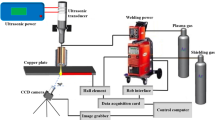Abstract
Ultrasonic vibration-assisted plasma arc welding with controlled pulse current waveform was developed to weld the 8 mm thick stainless steel plates. Both bead-on-plate and butt welding experiments were carried out with open-loop and closed-loop control strategies under different welding conditions. The signals of welding current and efflux plasma voltage and the images of keyhole exit were sensed to monitor the keyhole status during the welding process. It was found that the ultrasonic vibration-assisted plasma arc can completely penetrate the stainless steel plates with the thickness of 8 mm in a single pass with higher welding speed or lower peak welding current in controlled pulse keyhole mode. By continuous real-time adjustment of welding current waveform in closed-loop strategy, the “one-pulse-one-open keyhole” mode was achieved successfully with lower welding heat input. Due to the reduction of heat input and further constriction of plasma arc under the action of ultrasonic vibration, the weld was narrowed and the depth-width ratio was raised.
















Similar content being viewed by others

References
Wu CS, Wang L, Ren WJ, Zhang XY (2014) Plasma arc welding: process, sensing, control and modeling. J Manuf Process 16:74–85. https://doi.org/10.1016/j.jmapro.2013.06.004
Bashenko VV, Sosnin NA (1988) Optimization of the plasma arc welding process. Weld J 67:233s–237s
Vredeveldt HL (2014) Increased power density plasma arc welding: the effect of an added radial gas flow around the arc root. Delft University of Technology, Dissertation
Li T, Yang XM, Chen L, Zhang Y, Cheng Lei Y, Chun YJ (2020) Arc behaviour and weld formation in gas focusing plasma arc welding. Sci Technol Weld Join 25:329–335. https://doi.org/10.1080/13621718.2019.1702284
Li TQ, Chen L, Zhang Y, Yang XM, Lei YC (2020) Metal flow of weld pool and keyhole evolution in gas focusing plasma arc welding. Int J Heat Mass Transf 150:119296. https://doi.org/10.1016/j.ijheatmasstransfer.2019.119296
Mahrle A, Schnick M, Rose S, Demuth C, Beyer E, Füssel U (2011) Process characteristics of fibre-laser-assisted plasma arc welding. J Phys D Appl Phys 44:345502. https://doi.org/10.1088/0022-3727/44/34/345502
Essers WG, Willems GAM, Buelens JJC, van Gompel MRM (1981) Plasma-Mig Welding - a new torch and arc starting method. Met Constr 13:36–42
Wu CS, Jia CB, Chen MA (2010) A control system for keyhole plasma arc welding of stainless steel plates with medium thickness. Weld J 89:225s–231s
Jia CB, Wu CS, Zhang YM (2009) Sensing controlled pulse key-holing condition in plasma arc welding. Trans Nonferrous Met Soc China 19:341–346. https://doi.org/10.1016/S1003-6326(08)60275-7
Jia C, Wu CS, Gao J (2010) Study on the thermal lag effect of keyhole in controlled pulse key-holing plasma arc welding. Acta Metall Sin 46:991–996. https://doi.org/10.3724/SP.J.1037.2010.00073
Liu ZM, Wu CS, Chen J (2013) Sensing dynamic keyhole behaviors in controlled-pulse keyholing plasma arc welding. Weld J 92:381s–389s
Kumar S, Wu CS, Padhy GK, Ding W (2017) Application of ultrasonic vibrations in welding and metal processing: a status review. J Manuf Process 26:295–322. https://doi.org/10.1016/j.jmapro.2017.02.027
Jose MJ, Kumar SS, Sharma A (2016) Vibration assisted welding processes and their influence on quality of welds. Sci Technol Weld Join 21:243–258. https://doi.org/10.1179/1362171815Y.0000000088
Da Cunha TV, Bohórquez CEN (2015) Ultrasound in arc welding: a review. Ultrasonics 56:201–209. https://doi.org/10.1016/j.ultras.2014.10.007
Sun QJ, Lin SB, Yang CL, Zhao GQ (2009) Penetration increase of AISI 304 using ultrasonic assisted tungsten inert gas welding. Sci Technol Weld Join 14:765–767. https://doi.org/10.1179/136217109X12505932584772
Fan Y, Yang C, Lin S, Fan C, Liu W (2012) Ultrasonic wave assisted GMAW. Weld J 91:91s–99s
Fan CL, Yang CL, Lin SB, Fan YY (2013) Arc characteristics of ultrasonic wave-assisted GMAW. Weld J 92:375s–379s
Fan C, Zhou L, Liu Z, Yang C, Lin S, Xie W, Tong H (2018) Arc character and droplet transfer of pulsed ultrasonic wave-assisted GMAW. Int J Adv Manuf Technol 95:2219–2226. https://doi.org/10.1007/s00170-017-1414-7
Wu CS, Zhao CY, Zhang C, Li YF (2017) Ultrasonic vibration-assisted keyholing plasma arc welding. Weld J 96:279s–286s
Li Y, Wu CS, Chen M (2019) Numerical analysis of the ultrasound induced arc pressure increment in plasma arc welding. J Phys D Appl Phys 52:035201. https://doi.org/10.1088/1361-6463/aae96d
Qiao J, Wu CS, Li Y (2020) Numerical and experimental investigation of keyholing process in ultrasonic vibration assisted plasma arc welding. J Manuf Process 50:603–613. https://doi.org/10.1016/j.jmapro.2020.01.019
Li Y, Wu CS, Chen M (2020) Numerical analysis of the heat-pressure characteristics in ultrasonic vibration assisted plasma arc. J Appl Phys 128:114903. https://doi.org/10.1063/5.0021540
Zhang C, Wu CS, Tian S (2020) Effect of ultrasonic vibration on current density and keyholing capability of plasma arc. Sci Technol Weld Join 25:422–430. https://doi.org/10.1080/13621718.2020.1735062
Wang L, Zhang C, Wu CS (2020) Experimental study on controlled pulse keyholing plasma arc welding assisted by ultrasonic vibration. Int J Adv Manuf Technol 107:4995–5009. https://doi.org/10.1007/s00170-020-05384-w
Funding
This study is funded by the National Natural Science Foundation of China (Grant No. 51775312) and the International Research Cooperation Seed Fund Program of Shandong University (Grant No. 31370088395401).
Author information
Authors and Affiliations
Corresponding author
Additional information
Publisher’s note
Springer Nature remains neutral with regard to jurisdictional claims in published maps and institutional affiliations.
Recommended for publication by Commission XII - Arc Welding Processes and Production Systems.
Rights and permissions
About this article
Cite this article
Tian, S., Wang, L., Wu, C. et al. Influence of ultrasonic vibration on keyholing/penetrating capability in plasma arc welding with controlled pulse waveform. Weld World 65, 1107–1117 (2021). https://doi.org/10.1007/s40194-021-01115-1
Received:
Accepted:
Published:
Issue Date:
DOI: https://doi.org/10.1007/s40194-021-01115-1



